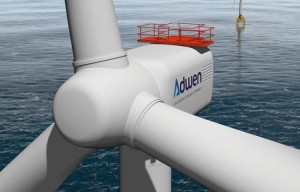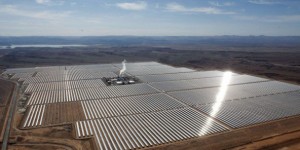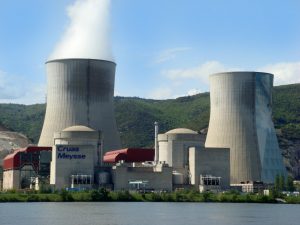In its latest annual report, World Energy Outlook 2017 (IEA, November 2017 www.iea.org ) the International Energy Agency (IEA), makes the assumption, based on its central scenario (so called New policies, which would not achieve the objectives of the Paris Agreement) a net slowdown in the growth of global demand for primary energy: it would grow only by 2% per year (it would fall in Europe and very slightly in the United States and would strongly grow in Asia, by almost 50%, and in Africa). Coal consumption would reach a plateau around 2040 while oil demand growth would weaken after 2025, gas growth remaining high. As far as non-carbon energies are concerned, their growth would be very strong: nearly 50% for nuclear power, 80% for renewable sectors (their cost would drop sharply), electricity demand growing by 60%. The CO2 balance of this scenario is not good since emissions associated  with the energy sectors would continue to grow until 2040. A « Sustainable Development » IEA scenario, more proactive, would make it possible to reach the objectives of the COP 21 (to limit global warming at a maximum of 2 ° C), with CO2 emissions falling sharply towards 2020 with the consumption of coal, and assuming a higher growth of renewable energies (with a very rapid one for electric vehicles). This scenario would also achieve the UN 2030 Agenda objectives: the universal access of all the inhabitants of the planet to a modern energy (today 1.1 billion of its inhabitants do not have electricity access). IEA considers that the development of renewable energies (they would ensure 40% of the electricity production in 2040 in its central scenario and 63% in the proactive scenario), with the improvement of the energy efficiency, is the key for energy decarbonization.
with the energy sectors would continue to grow until 2040. A « Sustainable Development » IEA scenario, more proactive, would make it possible to reach the objectives of the COP 21 (to limit global warming at a maximum of 2 ° C), with CO2 emissions falling sharply towards 2020 with the consumption of coal, and assuming a higher growth of renewable energies (with a very rapid one for electric vehicles). This scenario would also achieve the UN 2030 Agenda objectives: the universal access of all the inhabitants of the planet to a modern energy (today 1.1 billion of its inhabitants do not have electricity access). IEA considers that the development of renewable energies (they would ensure 40% of the electricity production in 2040 in its central scenario and 63% in the proactive scenario), with the improvement of the energy efficiency, is the key for energy decarbonization.
On this basis, we can make a prediction: during this half-century (2000-2050), the center of gravity of the world geopolitics of energy will move from Western countries to Asia. Indeed, if, in 1990, more than half (57%) of the world’s primary energy demand came from developed countries, those of the OECD, the Asian (excluding Japan) and Middle East one’s did not represent 20%, by 2050 the situation would be reversed, OECD countries would consume 30% of the world’s energy and Asian countries would consume half. This shift would reflect the rise of both Asian economies accompanying their population growth (that of India in particular) and associated with their technical and industrial capacity growth. According to the IEA, several indicators are markers of this geopolitical evolution: – the production of electricity would increase by 70% in China which would increase tenfold, by 2040, its electricity production by renewable sectors (solar and wind) and fivefold that of nuclear power – India would triple its electricity production by 2040 and  multiply its electricity production by solar and wind power (it is, it is true, very low) by a factor twelve – the OECD countries would be content to increase their electricity production by only 20% and to double their production by renewable (wind and solar) sectors, the nuclear one decreasing slightly. We must complete this future world panorama by observing that the United States and Russia will remain important oil and gas producers (the United States thanks to oil and shale gas, will become major gas exporters notably in the form of LNG), with OPEC countries accounting for half of world production in 2040.
multiply its electricity production by solar and wind power (it is, it is true, very low) by a factor twelve – the OECD countries would be content to increase their electricity production by only 20% and to double their production by renewable (wind and solar) sectors, the nuclear one decreasing slightly. We must complete this future world panorama by observing that the United States and Russia will remain important oil and gas producers (the United States thanks to oil and shale gas, will become major gas exporters notably in the form of LNG), with OPEC countries accounting for half of world production in 2040.
The IEA scenarios, like those of other international organizations, show a gradual change in the global geopolitical scene by the half-century. The roles of oil and gas are likely to be less critical even though gas will remain, according to the IEA, an « all-season energy” with a demand growing by 45% by 2040, driven by consumption in developing countries. The gas geopolitics will most likely remain an important part of the world energy picture, especially in Europe, with Russia playing a major role on this continent, as its gas pipeline exports are at the heart of the industrial and political European energy strategy (cf. the analysis of Thierry Bros on the Geopolitics of Russian gas, vector of power and economic stake, the Carnets of the Observatory, Paris / Moscow 2017), according and Thierry Bros : « The gas, the cleanest fossil energy and at the same time one of the most politicized in Europe » (Le Monde de l’Energie, on 30.01.2018, www.lemondedelenergie.com ).
Emerging countries in Asia, China and India in particular, and Japan, no doubt, will play a key role in the transition to low carbon energy. « When China changes, everything changes, » says the IEA in its World Energy Outlook 2017, whose indicators show current developments. Its leaders want to launch an « energy revolution » by developing both renewable energies (hydro, solar, wind and bioenergy) and the nuclear sector, an ambitious goal (see Pierre Papon, « China is it is engaged in an « energy revolution? », Futuribles Vigie, www.futuribles.com , and Le Monde de l’Energie, January 2018). China intends to be present in all new energy technologies that will spearhead its exports. Its « energy revolution » is an export product that will borrow, in particular, the « new route of silk ». It is already a major player in the global renewable energy market and the world leader in solar panels exports (a capacity of 20 GW exported) and well placed in the field of wind turbines and power plants using bioenergy. The same goes for nuclear power, which it hopes to become the world leader, thus damaging France’s position with EDF which is engaged in the Hinkley Point nuclear power station construction in Great Britain. It also shows very ambitious goals for the electric car (it accounted for 43% of global production in 2016) and the production of batteries (a quarter of the world production of lithium ion batteries).
The rise of renewable energies, especially solar and wind electricity, introduces a new degree of freedom in energy strategies. Indeed, no country has an ownership right on solar and wind energies whose exploitation is completely delocalized. Saudi Arabia has solar power to spare but it will not weigh on renewable energy markets. However, China’s industrial policy is thought provoking. Indeed, it relies on a mining strategy: it presently has a monopoly of the world’s production of rare earths (metals « critical » for renewable energies) and has taken stakes in lithium mines (notably Australia’s Greenbushes, ABC Net, Kathryn Diss, « Car industry revolution fuels Western Australia’s lithium boom » www.abc.net.au/news/…lithium-revolution…mining ). It shows, if it were needed, that the development of renewable energies development will, most likely, have a geopolitical dimension if we take into account the need to cover the metal needs for solar, wind and batteries: rare earths (such as dysprosium and neodymium used in the composition of metal alloys to make turbine magnets and electric car engines, gallium for solar cells…), lithium and cobalt for batteries, platinum for fuel cells. Even if a recycling of critical metals is feasible, countries that are in a monopoly situation, as China, would benefit from a strategic advantage. A mining policy will therefore be required and it is rarely taken into account.
Finally, it should be noted that, although several energy scenarios envisage a strong nuclear energy development, it can only reasonably be envisaged if, on the one hand, reactors and their fuel fulfill strict safety requirements and, on the other hand, proliferation risks of techniques and fuels for military uses are avoided. This implies an extension of the mandate of the International Atomic Energy Agency (IAEA), in Vienna, so that it can control new reactors safety before their commissioning and the application of the rules imposed by the NPT, as provided the Iranian nuclear deal, signed in Vienna in 2015, is a good example of successful multilateralism that is challenged, today, by President D. Trump. Nuclear power will also remain an important dimension of the geopolitics of energy.
envisaged if, on the one hand, reactors and their fuel fulfill strict safety requirements and, on the other hand, proliferation risks of techniques and fuels for military uses are avoided. This implies an extension of the mandate of the International Atomic Energy Agency (IAEA), in Vienna, so that it can control new reactors safety before their commissioning and the application of the rules imposed by the NPT, as provided the Iranian nuclear deal, signed in Vienna in 2015, is a good example of successful multilateralism that is challenged, today, by President D. Trump. Nuclear power will also remain an important dimension of the geopolitics of energy.
In this new context of the energy geopolitics, two major unknowns remain today: the place of Africa and that of Europe (cf. picture of a solar plant in Ouarzazate Marocco). Sub-Saharan Africa, which is not devoid of energy resources, renewable and fossil, will  not be able to ensure the access of all its population to a « modern » energy on short term, but will it succeed in 2050 ? It can only achieve this goal if it is able to mobilize capital on ambitious projects to build local and regional energy infrastructures. As for the European Union, which periodically faces the dilemma posed by its energy independence (in 2016 it imported 54% of its energy), it has not yet managed to define a common energy policy in order to guarantee the security of its energy supplies and to mobilize its scientific, technical and industrial assets on all fronts of the energy transition (from renewable energies to nuclear energy while passing through energy efficiency), the Berezina of the European solar industry is an illustration of this political deficiency. This mobilization is an emergency for Europe.
not be able to ensure the access of all its population to a « modern » energy on short term, but will it succeed in 2050 ? It can only achieve this goal if it is able to mobilize capital on ambitious projects to build local and regional energy infrastructures. As for the European Union, which periodically faces the dilemma posed by its energy independence (in 2016 it imported 54% of its energy), it has not yet managed to define a common energy policy in order to guarantee the security of its energy supplies and to mobilize its scientific, technical and industrial assets on all fronts of the energy transition (from renewable energies to nuclear energy while passing through energy efficiency), the Berezina of the European solar industry is an illustration of this political deficiency. This mobilization is an emergency for Europe.
